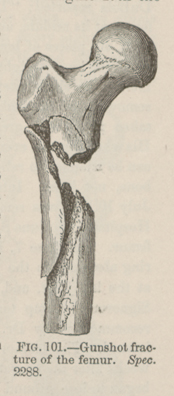Title: Bowman, Daniel H.
Source text: The Medical and Surgical History of the War of the Rebellion. (1861-65.), Part 3, Volume 2 (Washington, DC: Government Printing Office, 1883), 147.
Civil War Washington ID: med.d2e6679
TEI/XML: med.d2e6679.xml
CASE 322.—Private Daniel H. Bowman, Co. C, 110th Pennsylvania, aged 24 years, was wounded on July 27, 1864, at Deep Bottom, on the left bank of James River. A conoidal musket bull entered at the upper posterior part of the right thigh, comminuted the femur from the trochanters downward for several inches and lodged. The wounded man was transported to Washington on a hospital steamer, and was received at Lincoln Hospital on July 30th. The injured limb was shortened two and a half inches; the soft parts were badly lacerated. On August 7th the position of the ball at the anterior part of the thigh was detected. An incision was made and the ball and several detached fragments of bone were removed. On August 17th the wound looked badly, and there was slight sloughing. For the next few weeks the patient lost ground steadily. There was profuse suppuration, with great constitutional irritation. There appeared to be no attempt at union at the seat of the fracture. The patient had become much emaciated, and his powers of resistance were failing daily. After due consultation it was determined to amputate at the hip joint. On September 15th the operation was performed by Assistant Surgeon J. C. McKee, U. S. A. The patient was rendered insensible by sulphuric ether. The method by antero-posterior flaps formed by transfixion was adopted. The amputation was rapidly completed and very little blood was lost. The patient did not rally, but died one hour after the operation, September 15, 1864. At the autopsy, the lungs were found to be attached to the thoracic walls by firm fibrinous adhesions. In the upper lobe of the right lung there were two small isolated abscesses. Otherwise the lungs were normal. The right weighed 13 and the left 11 ounces. The abdominal viscera were normal, save that the liver and kidneys were unusually small, the former weighing 44½ and the latter 9½ ounces. At the seat of the fracture of the femur (FIG. 101) there was no attempt at repair; the fragments were carious: a large one, consisting of nearly half of the cylinder of the shaft, was four inches long and was quite detached. Fissures penetrated the trochanters and extended posteriorly half-way up the neck of the bone.
